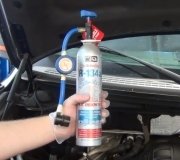Only if you lost your eye sight or your fingers got frostbitten. Professionals wear gloves, safety glasses, AND a face shield when working with refrigerant.
As for the car, seal up all the connections immediately to prevent air from getting in. The humidity in the air combines with refrigerant and the oil in the system to for corrosive conditions. That was a big problem with the older R-12 used through 1993. I don't know how the newer R-134 compares, but regardless, you don't want any hint of water circulating in the system. Besides the corrosion problem, water droplets will freeze at the tiny orifice the refrigerant goes through to become real cold, and it will block the flow of that refrigerant.
Once you remove the seals and reassemble everything, the system will have to be recharged. The first step involves injecting a little refrigerant into the system so they can check for leaks with an electronic detector. If none are found, they will remove that refrigerant, then pump the system into a vacuum for at least half an hour. That will make any moisture that got in boil at 77 degrees and get sucked out as a vapor. Then they will refill the system with the correct amount of new refrigerant.
SPONSORED LINKS
Thursday, January 31st, 2013 AT 3:40 AM



